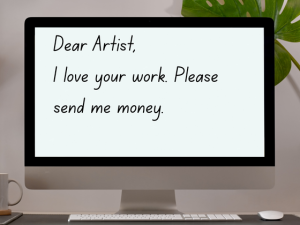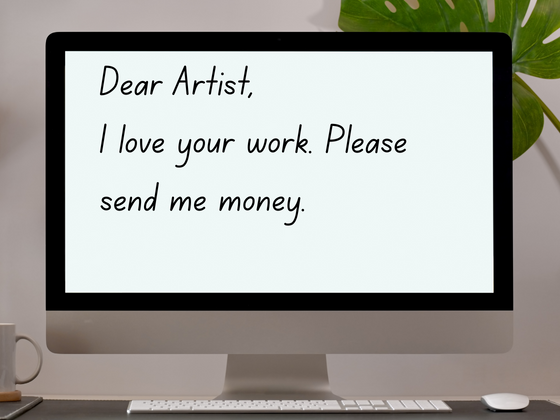We’d like to think we’re wise to endless variety of spam emails, but the art scam email can be particularly hard to spot. Not because these phishers are particularly canny, but because they prey on our hopes and vanity.
Unfortunately, anonymity of the Internet and the temptation of online sales will always attract con artists. Luckily, these art scammers are usually fairly easy to spot.
Read on to find out what these art scams look like, how to detect them and how to respond.

Why do scammers target artists?
At this point, anyone with an email address has received their share of scam emails. Someone from a suspicious email address asks you to please confirm your online banking login details. Or they warn you of fraud in your credit card. Or advise you that your hot water will be turned off tomorrow (in February!) since you didn’t pay your heating bill…
All scams have certain common elements: false urgency, fear of loss or humiliation, or an opportunity for a windfall.
Artists are certainly not the only group these con artists target, they can be easy marks for several reasons, both practical and psychological:
- Easy to Find: Your website tells the world you’re an artist and makes it very easy to get in touch.
- High-Ticket Items: Scammers can reap a better windfall from the “purchase” of a single artwork than they could from dozens of smaller e-commerce purchases.
- Art Requires Special (and Expensive) Shipping and Handling: It’s easier for them to make the request to reimburse the difference on shipping and handling, as these rates can be both high and difficult to estimate in advance.
- Artists Value Praise and Commercial Success: Is there an artist alive who doesn’t want to hear that their work is beautiful, and that someone urgently needs to purchase it for top-dollar. Compliments often cloud our judgement.
Anatomy of an Art Scam Email
Let’s look at an example of this common phishing email.
You open your email to find a message from an eager collector. They extol your work and tell you they want to buy a piece immediately. Sounds great, right? But that’s where it always gets weird. They press you with a sense of urgency — they need your art NOW! Oh, and by the way, a routine credit card transaction won’t work for them. Why don’t they send you a check? Incidentally, there’s some reason why they need to send you more than the cost of the artwork. But no problem! You can just refund them the difference…
The scam is usually from a web mail address (Yahoo, Gmail, etc.) from someone overseas who asks to buy your art work. They want to send you a check, money order or credit card number to pay for the art. The payment they give you is for the cost of the art work and the cost of shipping overseas. They will quickly ask you to send the overpayment to them or their “shipping agent”. So they essentially get you to send them money before you discover the payment is fraudulent.
ArtWeb members have received hundreds of these phony requests. So to protect the innocent, here’s a model of what these emails look like:
Dear [Artist],
My wife saw your work online and she really loves it! Your paintings are very beautifully and we will be overjoyed to own one.
I would like to buy your painting called [Title.]. I see the price is $3,000. I will send you a check for $7,000 from my friend’s bank account. You see, I am traveling right now and my bank is closed for a national holiday. My wife handles the credit card and I don’t want her to know about the surprise!!
So, you seem like a very trustworthy person. You can collect the extra $4,000, use it to pay shipping, and then I will give you my bank account and you can wire me the money. PLEASE! It is very urgent. My wife’s birthday is next week and she will be so sad if I don’t give her this painting.
I know i can count on you.
How to Identify an Email Scam
Here are the signs that the email ormessage you receive is not a genuine buyer:
- Too Good to Be True: The buyer may want to purchase several items at once or offers to pay above the price.
- Excessive but Unspecific Praise: Your work is marvelous, they say, but they don’t offer any specific reasons or identify a work.
- Grammar Mistakes and Odd Syntax: The email may be written in poor English, in formal and highly titled prose or contain lots of typos.
- Urgency: The writer offers an implausible reason why you need to act NOW or risk losing the sale.
- Special Arrangement Requested: A special shipping agent, refund of overpayment, etc.
- A Request to Reimburse Them: You are asked to send money for a shipping or transaction fee. Remember it is you that is selling the item!
- Generic Email Address: The email address may be from a Gmail, Yahoo or other major webmail account. The username may also be nonsensical or seemingly unconnected to the buyer’s stated name.
- Lack of Information on Your Work: The “buyer” has missed some fundamental detail. For example, they ask about your paintings, but your are a sculptor, or asks for prices that are clearly on your website.
- Something doesn’t feel quite right: Trust your instincts!
What To Do If You Suspect a Scam?
If you’re not quite certain whether the buyer is legit, but you’re not yet ready to alienate a potential customer, you can also do a little research to verify the validity of your buyer:
- Search the internet for the “buyer’s” email address, and see if any reports of fraud come up in the results.
- Check with other artists. Facebook groups and subreddits are a particularly good place to search for/annouce scam emails.
- Stick to your normal sale process. Insist the buyer uses PayPal or a credit card. Often the scam revolves around the payment mechanism, particularly a check that takes a few days to bounce.
- Never do anything until you can verify that you have cleared funds from a sales transaction. This cannot be stressed enough. You must be familiar with the clearing process of your bank and payment processors.
What Action You Can Take
- If you are certain you are dealing with a scammer, make no further communication. Block their email address.
- Write the scammer’s email provider at their “abuse” address (abuse@yahoo.com, abuse@gmail.com etc.) and include the message with its headers. Complain about the message and ask that the account be shut down. You may also file complaints with watchdog type services like Spamcop to get the email accounts shut down by their ISP. Spamcop and other services like it will parse the headers of the email and try to see through forged information to uncover the actual origin of the email, which is often useful in these matters.
How To Protect Yourself
- Stay informed by keeping abreast of consumer fraud trends.
- Don’t open spam. Delete it unread.
- Protect your computer from viruses, spyware, adware, worms, trojans, or other malware.
- If a gallery wants to exhibit your work, or a company wants to license your art, be sure to check the company’s validity.







